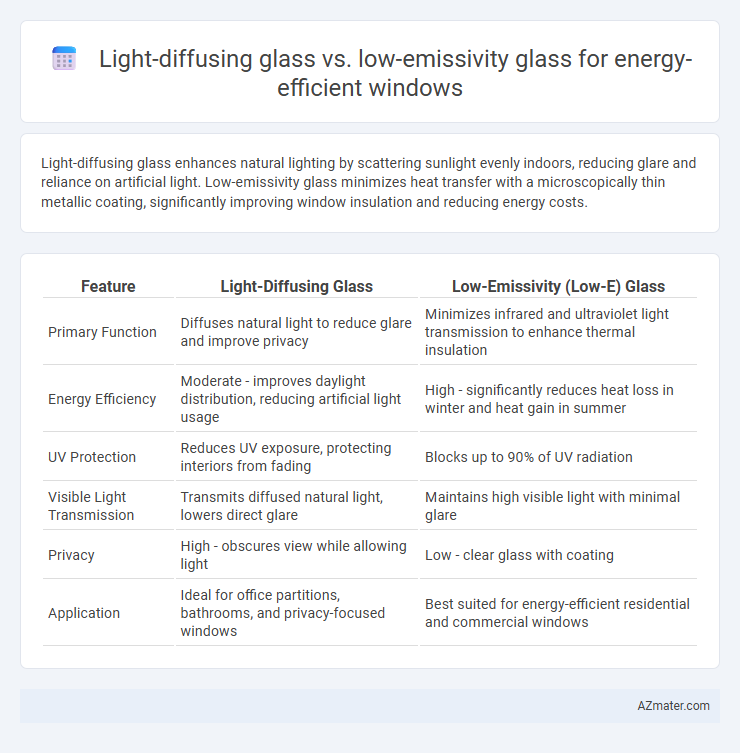Light-diffusing glass enhances natural lighting by scattering sunlight evenly indoors, reducing glare and reliance on artificial light. Low-emissivity glass minimizes heat transfer with a microscopically thin metallic coating, significantly improving window insulation and reducing energy costs.
Table of Comparison
| Feature | Light-Diffusing Glass | Low-Emissivity (Low-E) Glass |
|---|---|---|
| Primary Function | Diffuses natural light to reduce glare and improve privacy | Minimizes infrared and ultraviolet light transmission to enhance thermal insulation |
| Energy Efficiency | Moderate - improves daylight distribution, reducing artificial light usage | High - significantly reduces heat loss in winter and heat gain in summer |
| UV Protection | Reduces UV exposure, protecting interiors from fading | Blocks up to 90% of UV radiation |
| Visible Light Transmission | Transmits diffused natural light, lowers direct glare | Maintains high visible light with minimal glare |
| Privacy | High - obscures view while allowing light | Low - clear glass with coating |
| Application | Ideal for office partitions, bathrooms, and privacy-focused windows | Best suited for energy-efficient residential and commercial windows |
Introduction to Energy-Efficient Windows
Energy-efficient windows incorporate Light-diffusing glass to evenly distribute natural sunlight, reducing glare and minimizing reliance on artificial lighting, which enhances indoor comfort and lowers energy consumption. Low-emissivity (Low-E) glass features a microscopically thin coating that reflects infrared heat while allowing visible light to pass through, significantly improving thermal insulation and reducing heating and cooling costs. Combining Light-diffusing and Low-E glass technologies optimizes daylight usage and thermal performance, making them essential for sustainable building design and energy savings.
Understanding Light-Diffusing Glass: Key Features
Light-diffusing glass enhances energy-efficient windows by scattering natural light to reduce glare and evenly distribute illumination, improving indoor comfort and reducing reliance on artificial lighting. This type of glass incorporates micro-etching or frosted finishes to transmit diffuse light while maintaining privacy and minimizing hot spots. Its key features include maximizing daylight penetration, minimizing solar heat gain, and improving overall energy savings through balanced thermal performance.
What is Low-Emissivity (Low-E) Glass?
Low-Emissivity (Low-E) glass is a type of energy-efficient window glass coated with microscopically thin, transparent layers that reduce infrared and ultraviolet light transmission without compromising visible light. This coating minimizes heat transfer, keeping interiors warmer in winter and cooler in summer, thereby enhancing thermal insulation and reducing energy costs. In contrast to light-diffusing glass, which primarily scatters light to reduce glare, Low-E glass focuses on improving energy performance by controlling heat exchange.
How Light-Diffusing Glass Works in Energy Conservation
Light-diffusing glass scatters incoming sunlight to distribute natural light evenly throughout a room, reducing the need for artificial lighting and lowering energy consumption. This glass type minimizes glare and heat spots while maintaining daylight brightness, enhancing thermal comfort by reducing solar heat gain. By optimizing natural light diffusion, light-diffusing glass contributes to energy savings in cooling and lighting systems compared to traditional clear or low-emissivity glass options.
Energy Efficiency Benefits of Low-E Glass
Low-emissivity (Low-E) glass significantly improves energy efficiency by minimizing infrared and ultraviolet light penetration while allowing visible light to pass through, reducing heat transfer in both summer and winter. This selective coating on Low-E glass enhances insulation, leading to lower heating and cooling costs compared to traditional light-diffusing glass, which primarily diffuses light but lacks advanced thermal control. Low-E glass also prevents harmful UV rays from entering interiors, protecting furnishings and maintaining comfortable indoor temperatures year-round.
Comparing Thermal Performance: Light-Diffusing vs. Low-E Glass
Light-diffusing glass reduces glare and distributes natural light evenly but offers moderate insulation with a typical U-value around 2.8 W/m2K. Low-emissivity (Low-E) glass features a microscopically thin coating that significantly lowers thermal transmittance, achieving U-values as low as 1.1 W/m2K, enhancing energy efficiency by reflecting infrared heat. For superior thermal performance in energy-efficient windows, Low-E glass consistently outperforms light-diffusing glass by mitigating heat loss and gain effectively.
Impact on Natural Daylighting and Comfort
Light-diffusing glass enhances natural daylighting by scattering sunlight evenly across interior spaces, reducing glare and creating a more comfortable visual environment. Low-emissivity (Low-E) glass minimizes heat transfer by reflecting infrared radiation while allowing visible light to pass through, maintaining natural brightness without compromising thermal comfort. Combining these technologies improves energy efficiency by maximizing daylight use and reducing reliance on artificial lighting and climate control systems.
Cost Considerations and Installation Differences
Light-diffusing glass typically incurs lower upfront costs compared to low-emissivity (Low-E) glass, making it a budget-friendly option for enhancing natural light while reducing glare. Installation of light-diffusing glass is generally straightforward, similar to standard glass panes, whereas Low-E glass requires more specialized handling and precise fitting to maintain its thermal efficiency. Low-E glass, despite its higher initial expense and installation complexity, offers superior energy savings by minimizing heat transfer, which can result in greater long-term cost benefits.
Application Suitability: Residential and Commercial Use
Light-diffusing glass enhances natural light distribution, reducing glare and improving indoor comfort, making it ideal for residential spaces like living rooms and commercial environments such as offices and retail stores. Low-emissivity (Low-E) glass excels in minimizing heat transfer by reflecting infrared energy, which enhances energy efficiency and temperature control in both residential and commercial buildings, particularly in climates with extreme temperatures. Selecting between these glasses depends on whether the priority is optimizing natural light quality or maximizing thermal insulation for energy savings.
Which Glass Type is Right for Your Energy-Efficient Windows?
Light-diffusing glass enhances natural daylight distribution, reducing glare while maintaining privacy, ideal for spaces needing balanced illumination. Low-emissivity (Low-E) glass minimizes heat transfer by reflecting infrared energy, significantly improving thermal performance and reducing HVAC costs. Choosing the right glass depends on whether your priority is maximizing daylight quality or optimizing insulation for energy savings.

Infographic: Light-diffusing glass vs Low-emissivity glass for Energy-efficient window
 azmater.com
azmater.com